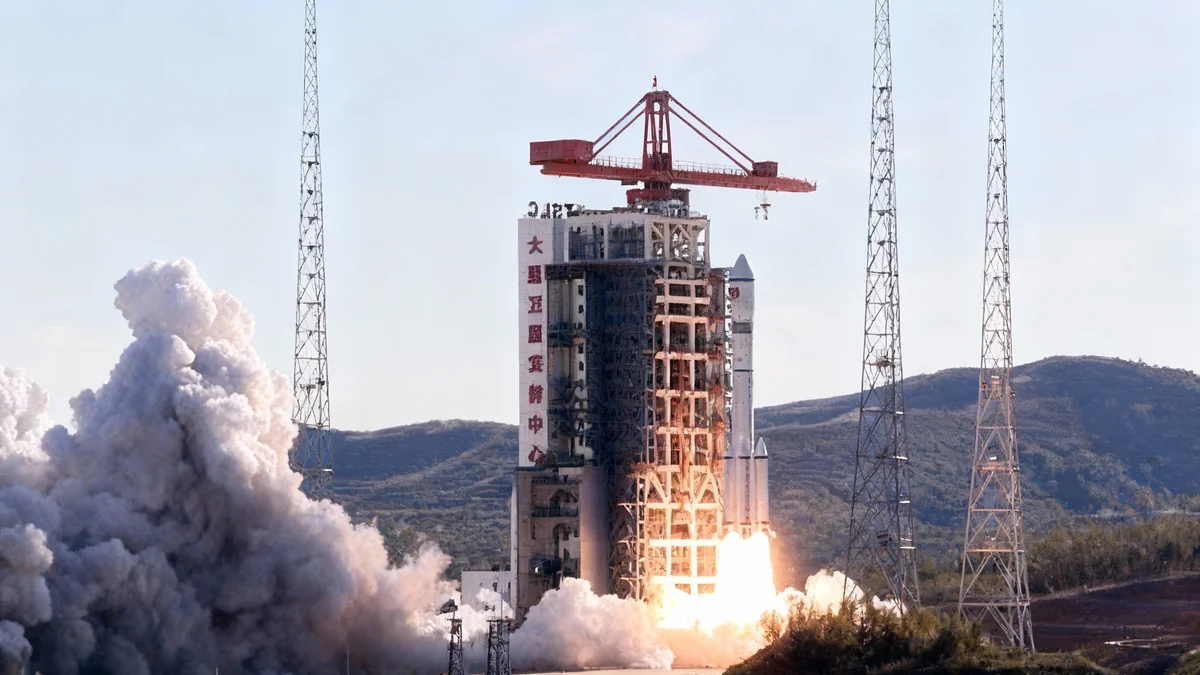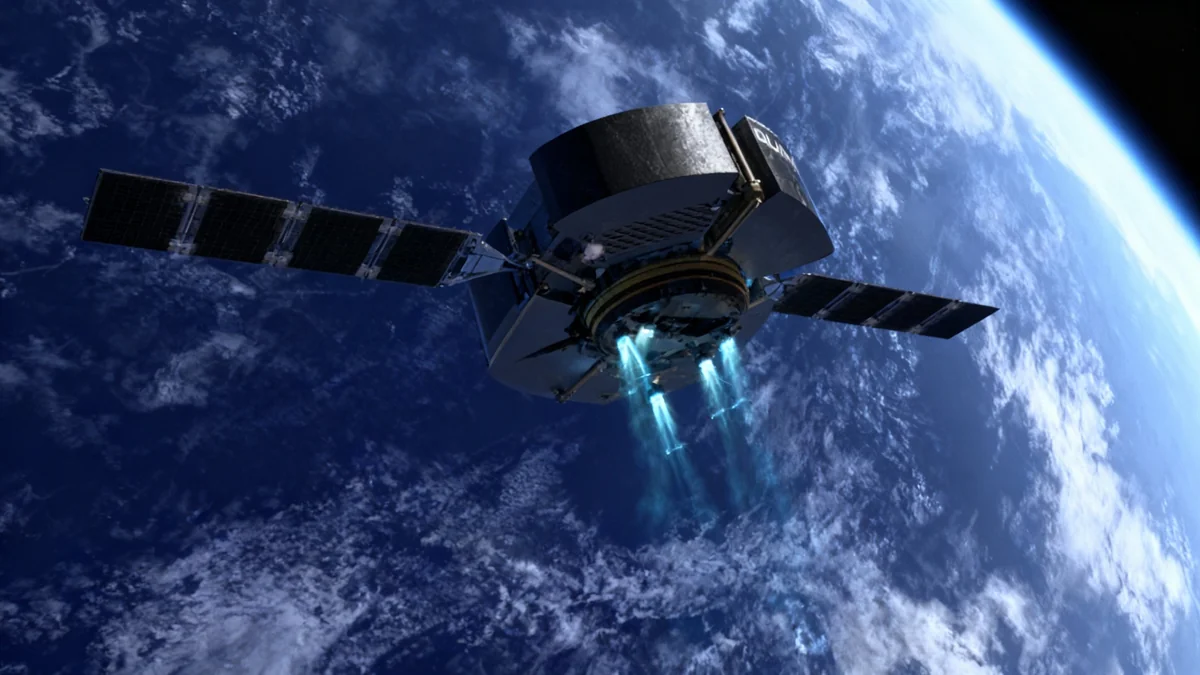China successfully conducted two separate rocket launches over a single weekend, deploying satellites for its burgeoning low Earth orbit internet constellation and for international partners. The missions, which took place from different launch sites, underscore the country's accelerating pace in space activities for both state-run and commercial projects.
The first launch on Friday, October 17, saw a Long March 6A rocket add more satellites to the Thousand Sails network, a project designed to provide global internet services. This was followed by a commercial launch on Saturday, October 18, which placed satellites into orbit for Pakistan and a Chinese research institute.
Key Takeaways
- China conducted two successful orbital launches on October 17 and 18.
- A Long March 6A rocket deployed the sixth batch of satellites for the Thousand Sails internet constellation.
- A commercial Kinetica-1 rocket launched a remote sensing satellite for Pakistan and two radar satellites.
- These missions mark China's 63rd and 64th orbital launches of the year, approaching its national record.
- The Thousand Sails project has now placed 108 satellites in orbit, though some have experienced technical issues.
Thousand Sails Constellation Continues to Grow
The first of the two missions began at 3:08 a.m. Eastern time on Friday, October 17, from the Taiyuan Satellite Launch Center in northern China. A Long March 6A rocket lifted off, carrying a new set of satellites for the Thousand Sails megaconstellation.
The China Aerospace Science and Technology Corporation (CASC), the nation's primary space contractor, confirmed the launch was a success. The payload was identified as Polar Group 18, the sixth batch of satellites for the ambitious internet project.
The Thousand Sails initiative, also known by names like Qianfan and G60 Starlink, is managed by Shanghai Spacecom Satellite Technology (SSST). Its goal is to create a large network of satellites in low Earth orbit to deliver internet connectivity, similar to SpaceX's Starlink.
Satellite Deployment and Constellation Status
While the exact number of satellites deployed in this mission was not officially stated, previous launches for the constellation have each carried 18 satellites. This mission was the first dedicated to Thousand Sails since March 2024. The flat-panel satellites were manufactured by the Shanghai Engineering Center for Microsatellites (SECM), also known as Microsat.
Long March 6A Capabilities
The Long March 6A is a modern launch vehicle that uses a combination of liquid and solid propellants. It features a core stage powered by kerosene and liquid oxygen, supplemented by four solid propellant side boosters. This design allows it to carry up to 4,500 kilograms of payload to a 700-kilometer sun-synchronous orbit.
With this latest launch, a total of 108 Thousand Sails satellites have now been placed into orbit. However, data from space activity trackers indicates that the project has faced some challenges.
According to statistics compiled by Jonathan McDowell, an astrophysicist who tracks space activities, 14 satellites from previous launches have failed to properly raise their orbits. These satellites are now in decaying orbits, with 10 of the affected units originating from the second launch batch.
This highlights the technical hurdles involved in deploying and operating a large-scale satellite megaconstellation. Despite these issues, the project is moving forward with an aggressive launch schedule.
Commercial Involvement in Thousand Sails
A significant development for the Thousand Sails project is the recent inclusion of commercial launch providers. Shanghai Spacecom Satellite Technology has awarded contracts to three private Chinese companies—Landspace, Space Pioneer, and CAS Space—to launch future batches of satellites.
These contracts cover seven launches that will deploy a total of 94 additional satellites. The total value of these launch services is reported to be approximately $187 million. This move marks a strategic shift, integrating China's growing commercial space sector into its national-level projects.
New Generation of Commercial Rockets
The commercial companies are expected to use their new, more powerful rockets for these missions. The launchers slated for use include Landspace's Zhuque-3, Space Pioneer's Tianlong-3, and CAS Space's Kinetica-2. All three are new vehicles scheduled to have their first test flights before the end of the year, signaling a major step up in capability for China's private space industry.
This initiative follows an earlier tender process that failed due to a lack of sufficient bidders, suggesting the commercial market is now mature enough to support such large-scale government-backed projects.
Second Weekend Launch Carries International Payloads
Just a day later, China's commercial sector conducted another successful mission. At 11:33 p.m. Eastern on Saturday, October 18, a Kinetica-1 solid rocket, operated by CAS Space, lifted off from the Jiuquan Satellite Launch Center in northwest China.
CAS Space confirmed the mission's success shortly after launch. The rocket placed three satellites into orbit:
- PRSS-2-HS1: A hyperspectral remote sensing satellite for Pakistan. This is the third remote sensing satellite China has launched for Pakistan this year.
- AIRSAT 03 and 04: Two satellites for the Aerospace Information Research Institute of the Chinese Academy of Sciences (AIRCAS). These will be part of a synthetic aperture radar (SAR) constellation.
Information on the rocket's payload fairing also indicated the involvement of Microsat and TerraX, a company based in Malaysia, highlighting the international collaboration in this launch.
Kinetica-1's Track Record
This mission marked the ninth flight for the Kinetica-1 rocket and its eighth success. According to CAS Space, the rocket has now delivered a total of 73 payloads to orbit, with a combined mass exceeding nine metric tons.
The Kinetica-1 is a four-stage solid-propellant rocket capable of carrying 1,500 kilograms to a 500-kilometer sun-synchronous orbit. It stands 30 meters tall and has a takeoff weight of 135 tons, making it a reliable workhorse for China's commercial launch market.
China's Rapid Launch Pace in 2025
These two launches were China's 63rd and 64th of the year, putting the country on track to potentially surpass its national record of 68 orbital launches set in 2024. This high frequency demonstrates a robust and expanding space infrastructure supporting both national and commercial ambitions.
The weekend's activities followed another major milestone on October 16, when China completed the 600th launch of a Long March series rocket. That mission deployed another set of satellites for Guowang, a separate state-owned internet megaconstellation.
Looking ahead, China's launch schedule remains packed. The next major launch is expected to be a Long March 5 from the Wenchang spaceport around October 22. This will likely be followed by a Long March 3B launch on October 26 and the Shenzhou-21 crewed mission to the Tiangong space station before the end of the month.





